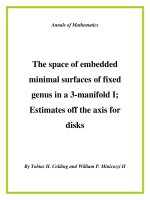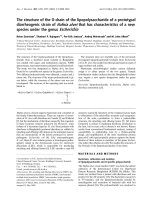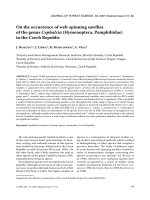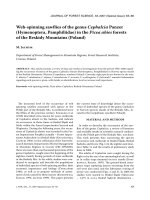genus Cheiracanthium
Bạn đang xem bản rút gọn của tài liệu. Xem và tải ngay bản đầy đủ của tài liệu tại đây (5.47 MB, 13 trang )
A peer-reviewed open-access journal
ZooKeys 762: 33–45 (2018)
Four species of spider genus Cheiracanthium C. L. Koch, 1839 (Araneae, Eutichuridae)...
doi: 10.3897/zookeys.762.23786
RESEARCH ARTICLE
33
Launched to accelerate biodiversity research
Four species of spider genus Cheiracanthium
C. L. Koch, 1839 (Araneae, Eutichuridae)
from Jinggang Mountains, Jiangxi Province, China
Jianshuang Zhang1, Guren Zhang2, Hao Yu2,3
1 School of Life Sciences, Guizhou Normal University, Guiyang, Guizhou, China 2 State Key Laboratory for
Biocontrol, Sun Yat-Sen University, Guangzhou, Guangdong, China 3 College of Chemistry and Life Sciences,
Integrated Mountain Research Institute, Guizhou Education University, Guiyang, Guizhou, China
Corresponding author: Hao Yu ()
Academic editor: Shuqiang Li | Received 22 January 2018 | Accepted 6 May 2018 | Published 30 May 2018
/>Citation: Zhang J, Zhang G, Yu H (2018) Four species of spider genus Cheiracanthium C. L. Koch, 1839 (Araneae,
Eutichuridae) from Jinggang Mountains, Jiangxi Province, China. ZooKeys 762: 33–45. />zookeys.762.23786
Abstract
Four species of spider genus Cheiracanthium C. L. Koch, 1839 are reported from Jinggang Mountains,
Jiangxi Province, China. Two of them are described as new to science: C. auriculatum sp. n. (♀♂) and
C. echinulatum sp. n. (♂). Cheiracanthium taiwanicum Chen, Huang, Chen & Wang, 2006 is recorded
from Mainland China for the first time. Cheiracanthium zhejiangense Hu & Song, 1982, the most similar
species to C. auriculatum sp. n., is a newly recorded species of Jiangxi Province. Detailed descriptions,
diagnoses, and photographs of the two new species are given. Cheiracanthium taiwanicum and C. zhejiangense are also illustrated.
Keywords
Taxonomy, morphology, description, new species
Copyright Jianshuang Zhang et al. This is an open access article distributed under the terms of the Creative Commons Attribution License (CC
BY 4.0), which permits unrestricted use, distribution, and reproduction in any medium, provided the original author and source are credited.
34
Jianshuang Zhang et al. / ZooKeys 762: 33–45 (2018)
Introduction
Cheiracanthium C. L. Koch, 1839 contains 210 catalogued species and is mainly distributed in the Old World (Marusik and Fomichev 2016; World Spider Catalogue
2018). Although this genus is relatively large and well known, its taxonomy is rather
poorly studied. Almost half of its species are known from single sex or juveniles: 36
by males, 60 by females, 2 by juveniles (World Spider Catalogue 2018). Additionally,
16 species were never illustrated and many species were described based on poor illustrations. So far, the genus has not been the subject of any global or regional revisions
(Marusik and Fomichev, 2016).
The Cheiracanthium fauna of China is relatively rare and poorly represented, with
only 38 described species (Li and Lin 2016; World Spider Catalogue 2018), of which
14 species are known based on a single sex: for 11, only females are known, and for
three, only males are known (World Spider Catalogue 2018). Additionally, illustrations of the internal structure of the epigyne are not provided in five species (World
Spider Catalogue 2018). Moreover, the diversity of this genus in China is still insufficiently known and several new species have been described in the last few years (Chen
and Huang 2012; Barrion et al. 2013; Wang and Zhang 2013).
Field collection in Jinggang Mountains of Jiangxi province, China, was carried
out in April 2011. During this field exploration, four Cheiracanthium species were
found: C. auriculatum sp. n., C. echinulatum sp. n., C. taiwanicum Chen, Huang,
Chen & Wang, 2006 and C. zhejiangense Hu & Song, 1982. Descriptions and photographs of the new species, as well as supplementary micrographs of the known
species, are provided.
Materials and methods
Spiders were fixed and preserved in 80% ethanol. Specimens were examined with an
Olympus SZX7 stereomicroscope; details were studied with an Olympus BX51 compound microscope. Male palps and female epigynes were examined and illustrated
after being dissected. Epigynes were cleared in boiling KOH solution to dissolve soft
tissues. Photographs were made with a Leica DFC450 digital camera mounted on an
Olympus BX51 compound microscope. The digital images were taken and assembled
using Helicon Focus 3.10 software package.
All measurements were obtained using an Olympus SZX7 stereomicroscope and
given in millimetres. Eye diameters are taken at the widest point. The total body length
does not include chelicerae or spinnerets length. Leg lengths are given as total length
(femur, patella, tibia, metatarsus, tarsus). The type specimens of the new species are
deposited in College of Chemistry and Life Sciences, Guizhou Education University,
Guiyang, Guizhou, China.
Four species of spider genus Cheiracanthium C. L. Koch, 1839 (Araneae, Eutichuridae)...
35
Abbreviations used are:
Aatrium;
AER
anterior eye row;
AL
abdomen length
ALE
anterior lateral eyes;
AME
anterior median eyes;
AME–AME distance between AMEs;
AME–ALE distance between AME
and ALE;
AW
abdomen width;
Cconductor;
CD
copulatory duct;
CF
cymbial fold;
CI
carapace index;
CL
carapace length;
CLL
clypeal length;
CO
copulatory opening;
CS
cymbial spur;
CW
carapace width;
DTA
dorsal tibial apophysis;
Eembolus;
EBembolic base;
fertilisation duct;
total length of leg I;
leg I / carapace length;
median ocular quadrangle;
MOQ anterior width;
MOQ posterior width;
ocular area length;
ocular area width;
posterior eye row;
posterior lateral eyes;
posterior median eyes;
distance between PMEs;
distance between PME
and PLE;
PTA
prolateral tibial apophysis;
RTA
retrolateral tibial apophysis;
Rreceptacle;
STL
sternum length;
STW
sternum width;
TA
tegular apophysis;
FD
LL
LL:CL
MOQ
MOQA
MOQP
OAL
OAW
PER
PLE
PME
PME–PME
PME–PLE
total body length.
Leg setae: v, ventral; p, prolateral; r, retrolateral. Most of the terminologies used in
text and figure legends followed Lotz (2015), while a few others followed Marusik and
Fomichev (2016) and Morano and Bonal (2016).
TL
Taxonomy
Genus Cheiracanthium C. L. Koch, 1839
Cheiracanthium auriculatum sp. n.
/>Figs 1, 5
Type material. Holotype ♂ (SYSU-JX-11-177): China, Jiangxi Province, Jinggang Mountains Nature Reserve, Xiangzhou village (380 m; 26°35'30.23"N,
36
Jianshuang Zhang et al. / ZooKeys 762: 33–45 (2018)
Figures 1. Cheiracanthium auriculatum sp. n., male holotype and female allotype. Aleft palp, prolateral view B same, ventral view C same, retrolateral view D epigyne, ventral view E vulva, dorsal view
F male habitus, dorsal view G female habitus, dorsal view. Scale bars: 0.5 mm (A–C); 0.2 mm (D–E);
2 mm (F–G).
Four species of spider genus Cheiracanthium C. L. Koch, 1839 (Araneae, Eutichuridae)...
37
114°15'59.93"E), 26 April 2011, Hao Yu and Zhenyu Jin leg. Paratypes: 1♂ and 3 ♀,
same data as holotype.
Etymology. The specific epithet is an adjective and is derived from a Latin word
“auriculatus“(ear-like), referring to the tegular apophysis which is like the contour of
an ear in ventral view.
Diagnosis. Cheiracanthium auriculatum sp. n. is distinguished from all other Cheiracanthium species, except C. zhejiangense Hu & Song, 1982 (Fig. 4A–E), by having a
distally filiform cymbial spur in the male, and by the general shape of the vulva in the
female. From C. zhejiangense, the male can be distinguished by the ear contour-shaped
tegular apophysis and the uncoiling tip of cymbial spur (vs the falciform tegular apophysis and the coiled tip of the cymbial spur in C. zhejiangense) (Figs 1A–C; 4A–C),
the female can be differentiated by the indistinct atrium and copulatory ducts (vs the
distinct atrium and copulatory ducts in C. zhejiangense), the more or less lengthwise
receptacles (vs the nearly horizontal receptacles in C. zhejiangense) (Figs 1D–E; 4D–E),
and by the different coil number of copulatory ducts (7 coils in C. auriculatum sp. n.,
instead of 8 coils in C. zhejiangense) (Figs 1E; 4E). In addition, the two species can by
separated by their habitus: abdomen without distinct colour pattern in C. auriculatum
sp. n. (Fig. 1F–G), but with a median heart-shaped mark which reaches half of the
opisthosoma length in C. zhejiangense (Fig. 4F–G).
Description. Male. Total length 8.58–9.15. Holotype (Fig. 1A–C, F): TL 9.15;
CL 3.73, CW 2.41, CI (CL/CW) 1.55; AL 4.05, AW 2.42. Carapace (Fig. 1F) brown,
uniformly coloured, without distinct pattern. Eye sizes and inter-distances: OAL 0.39,
OAW 1.45; AME 0.14, ALE 0.16, PME 0.16, PLE 0.17; AME–AME 0.27, AME–ALE
0.27, PME–PME 0.36, PME–PLE 0.35; MOQA 0.56, MOQP 0.67, CLL 0.10. Chelicerae protruding and reddish brown, with 3 teeth on promargin and 3 on retromargin respectively. Sternum dark brown, STL 1.69, STW 1.44. Labium and endites brown. Legs
yellowish-white, without distinct colour markings. Leg measurements: I 18.84 (4.65,
1.22, 5.10, 5.60, 2.26), II 12.09 (3.30, 1.14, 3.24, 3.23, 1.19), III 8.61 (2.38, 0.86,
1.92, 2.40, 1.05), IV 12.47 (3.72, 0.95, 3.17, 4.00, 1.07); LL:CL 5.03. Leg spines: I 0-01p, 2v-1v-1p, 2v1p-1p1v-1v; II 0-0-1p, 1v-2v-1p, 2v1p-1v1p-1v; III 0-0-1p1r, 0-1p1r0, 2v1p-1p1r-1v2p2r; IV 0-0-1p1r, 1v-1v1p-0, 2v1p-1v1p1r-1v2p2r. Abdomen (Fig. 1F)
elongate-oval, dorsally grey, dorsum with indistinct heart-shaped mark and two pairs of
not obvious muscle depressions; venter brownish without distinct pattern.
Palp (Fig. 1A–C). Tibia extremely long, about as long as cymbium, with two apophyses; retrolateral tibial apophysis (RTA) about 20% of tibia length, with a more or
less bifurcate apex and hiding behind tegulum; prolateral tibial apophysis (PTA) small
and round; cymbial spur (CS) is approximately equal in length to tibia, tapering off
into a filiform; cymbial fold (CF) poorly developed, for approximately 4/5 the length
of cymbium; tip of cymbium short, about 1/4 of cymbium length. Tegulum oblong,
1.3 times longer than wide; tegular apophysis (TA) long and sinuate, more than 4/5
of tegulum length, filamentous and like an ear’s contour in ventral view; embolus (E)
arising at approximately 10 o’clock position, terminating at approximately 11 o’clock
position, it’s tip covered by conductor (C); conductor large, falciform.
38
Jianshuang Zhang et al. / ZooKeys 762: 33–45 (2018)
Female. Total length 8.66–9.30. Slightly larger in size and lighter in colour. Allotype (Fig. 1D–E, G) measured: TL 9.30; CL = 3.03, CW = 2.22, CI (CL/CW) = 1.36;
AL = 4.95, AW = 2.92. Eye diameters and inter-distances: OAL 0.37, OAW 1.23;
AME 0.14, ALE 0.19, PME 0.13, PLE 0.14; AME–AME 0.23, AME–ALE 0.11,
PME–PME 0.31, PME–PLE 0.23; MOQA 0.46, MOQP 0.58, CLL 0.24. PMT:
RMT = 6:6.STL 1.47, STW 1.23. Leg measurements: I 12.70 (3.30, 1.06, 3.42, 3.39,
1.54), II 8.51 (2.42, 0.86, 2.23, 2.05, 0.96), III 6.42 (1.92, 0.69, 1.35, 1.65, 0.80),
IV 9.67 (2.75, 0.89, 2.39, 2.68, 0.96); LL:CL 4.19. Leg spines: I 0-1p-1p, 2v-2v0, 2v-1p1r-1v; II 0-0-1p, 1v-2v-1p, 2v1p-1p1r-1v; III 0-1p-1p1r, 1v-1p1r-0, 2v1p1r-1p1r-1v2p2r; IV 0-0-1p1r, 1v-1v1p1r-0, 2v1p1r-1v1p1r-1v2p2r.
Epigyne (Fig. 1D–E). Atrium (A) indistinct, without delimited margin, about four
times wider than long; receptacles (R) are faintly visible through epigynal plate in
ventral view; two copulatory openings (CO) located at lateral borders of atrium; the
transparent copulatory ducts (CD) running spirally (length of spira about 1.4 times
longer than receptacles), forming 7 entwined loops (including 4 ascending coils and 3
descending coils); receptacle sickle-shaped, separated by three diameters.
Distribution. Presently known only from the type locality, Jinggang Mountains,
Jiangxi, China (Fig. 5).
Cheiracanthium echinulatum sp. n.
/>Figs 2, 5
Type material. Holotype ♂ (SYSU-JX-11-182): China, Jiangxi Province, Jinggang Mountains Nature Reserve, Xiangzhou village (380 m; 26°35'30.23"N,
114°15'59.93"E), 26 April 2011, Hao Yu and Zhenyu Jin leg. Paratypes: 1♂, same
data as holotype.
Etymology. The species epithet is taken from the Latin adjective echinulatus and
refers to the spinule-shaped tegular apophysis.
Diagnosis. This new species resembles C. taegense Paik, 1990 (Paik, 1990: 11, f.
39–47; Baba & Yoshitake, 2016: 39, f. 1–4) in having the similar beak-shaped cymbial
spur, and stalk-like dorsal tibial apophysis, but can be distinguished by: (1) the embolus originated at 3 o’clock position (Fig. 2B–C), vs. originated at 1–2 o’clock position
in C. taegense (Paik, 1990: 11, f. 41; Baba & Yoshitake, 2016: 39, f. 3–4); (2) tegular
apophysis smaller, straight and acicular (Fig. 2A–C), instead of bigger and slightly
curved in C. taegense (Paik, 1990: 11, f. 41, 43; Baba & Yoshitake, 2016: 39, f. 3–4);
(3) RTA straight and digitiform (Fig. 2A–C), but with a curved and hook-shaped apex
in C. taegense (Baba & Yoshitake, 2016: 39, f. 3–4).
Description. Male. Total length 9.06–9.12. Holotype (Fig. 2): TL 9.06; CL 3.58,
CW 2.34, CI (CL/CW) 1.53; AL 4.99, AW 2.27. Carapace (Fig. 2D, F) yellow except
reddish ocular area, without distinct colour pattern. Eye sizes and inter-distances: OAL
0.34, OAW 1.26; AME 0.15, ALE 0.15, PME 0.14, PLE 0.13; AME–AME 0.46,
Four species of spider genus Cheiracanthium C. L. Koch, 1839 (Araneae, Eutichuridae)...
39
Figures 2. Cheiracanthium echinulatum sp. n., male holotype. Aleft palp, prolateral view B same, ventral
view C same, retrolateral view D male habitus, dorsal view E same, ventral view F same, lateral view. Scale
bars: 0.5 mm (A–C); 2 mm (D–F).
40
Jianshuang Zhang et al. / ZooKeys 762: 33–45 (2018)
AME–ALE 0.25, PME–PME 0.54, PME–PLE 0.22; MOQA 0.43, MOQP 0.55,
CLL 0.13. Chelicerae light brown and robust, with long and wine-coloured fangs, with
3 teeth on promargin and 3 on retromargin respectively. Sternum (Fig. 2E) yellowish,
STL 1.79, STW 1.32. Labium and endites brown. Legs yellowish, without distinct
colour markings. Leg measurements: I 23.70 (5.90, 1.05, 7.31, 7.99, 1.46), II 14.92
(3.41, 0.82, 4.14, 5.26, 1.29), III 11.10 (2.53, 1.43, 2.16, 3.94, 1.03), IV 16.42 (4.18,
1.21, 4.13, 5.66, 1.24); LL:CL 6.62. Leg spines: I 0-1p1r-1p1r, 3v-3v-1v1p, 2v-0-1v;
II 0-1p1r-1p1r, 3v-2v-1v1p, 2v1p-2v1p-1v; III 0-1p1r-1p1r, 2v1p1r-1p1r-0, 2v1p1r2v1p1r-2v1p2r; IV 0-1p1r-1p1r, 1v1p1r-1v2r-1v1r, 2v1p1r-2v1p1r-1v1p3r. Abdomen
(Fig. 2D–F) lanceolate, dorsally yellowish white, scattered numerous indistinct pigmented spots; venter yellowish without distinct pattern.
Palp (Fig. 2A–C). Tibia twice shorter than cymbium, with three apophyses; retrolateral tibial apophysis (RTA) about 50% of tibia length, heavily sclerotised and with
a fingerlike apex; prolateral tibial apophysis (PTA) distinctly elevated and relatively
short, about 30% of tibia length, coniform in prolateral view and digitiform in ventral
view; dorsal tibial apophysis (DTA) thin and stalk-shaped, about as long as RTA; cymbial spur (CS) beak-shaped, twice shorter than tibia; cymbial fold (CF) strongly developed and well visible in ventral and retrolateral view, for approximately 2/3 the length
of cymbium; tip of cymbium long, about 1/3 of cymbium length. Tegulum 1.3 longer
than wide, membranous and semitransparent except its margin in ventral view; tegular
apophysis (TA) short and thin, spiculate; embolus (E) starts on the retrolateral flank
(approximately 3 o’clock of tegulum), surrounds the base and ends at conductor (C)
apex, its tip filiform and curved behind conductor; conductor large and membranous.
Female. Unknown.
Comments. According to the World Spider Catalogue 2018, a total of 11 Cheiracanthium species are known from females only in China: C. approximatum O. P.Cambridge, 1885, C. escaladae Barrion et al., 2013, C. fujianense Gong, 1983, C.
hypocyrtum Zhang & Zhu, 1993, C. liuyangense Xie et al., 1996, C. olliforme Zhang
& Zhu, 1993, C. potanini Schenkel, 1963, C. rupicola (Thorell, 1897), C. solidum
Zhang et al., 1993, C. sphaericum Zhang et al., 1993, C. longtailen Xu, 1993. Among
them, C. escaladae is supposedly a Clubiona species based on epigyne morphology,
while C. potanini is supposededly doubtful because of the poor original illustrations
and description. The other nine can be considered tentatively as valid Cheiracanthium
species. However, none of them could be matched with C. echinulatum sp. n. due to
their different habitus (abdomen without distinct colour pattern in C. echinulatum sp.
n., but with a median heart-shaped mark in C. approximatum, C. fujianense and C.
rupicola, with two pairs of muscular depressions in C. hypocyrtum, C. liuyangense and
C. sphaericum) and different number of cheliceral teeth (chelicerae with 3 promarginal
and 3 retromarginal teeth in C. echinulatum sp. n., but with 3 promarginal and 2 retromarginal teeth in C. hypocyrtum, C. olliforme and C. sphaericum, with 3 promarginal
and 1 retromarginal teeth in C. liuyangense, with 2 promarginal and 1 retromarginal
teeth in C. solidum, with 2 promarginal and 3 retromarginal teeth in C. longtailen).
Four species of spider genus Cheiracanthium C. L. Koch, 1839 (Araneae, Eutichuridae)...
41
Distribution. Presently known only from the type locality, Jinggang Mountains,
Jiangxi, China (Fig. 5).
Cheiracanthium taiwanicum Chen, Huang, Chen & Wang, 2006
Figs 3, 5
Cheiracanthium taiwanicum Chen et al., 2006: 10, fig. 1A–E; Chen and Huang 2012:
25, fig. 7A–G, pl. 2C–D, 3A–B.
Examined material. 1♂ and 1♀, China, Jiangxi Province, Jinggang Mountains Nature Reserve, Hexiliong village (680 m; 26°31'51.54"N, 114°8'46.02"E), 30 April 2011,
Hao Yu leg.
Description. Male and female (Fig. 3). For details see Chen and Huang (2012).
Distribution. Jinggang Mountains in Jiangxi and Nantou County in Taiwan, China.
Cheiracanthium zhejiangense Hu & Song, 1982
Figs 4–5
Cheiracanthium zhejiangensis Hu & Song, 1982: 56, fig. 4A–D.
Cheiracanthium zhejiangense Paik 1990: 9, fig. 26–38.
Remarks. See the World Spider Catalogue for the full list of references.
Examined material. 1♂ and 2♀, China, Jiangxi Province, Jinggang Mountains
Nature Reserve, Xiangzhou village (380 m; 26°35'30.23"N, 114°15'59.93"E), 26
April 2011, Hao Yu leg.
Description. Male and female (Fig. 4). Description of habitus, see Paik (1990). Since
previous descriptions are rather brief, redescription of genitalia is provided as below.
Palp (Fig. 4A–C). Tibia about as long as cymbium, with only retrolateral apophysis; apophysis about 20% of tibia length, with a sharp apex and hiding behind tegulum; cymbial spur slightly shorter than tibia, tapering off into a thread and terminally
coiled; cymbial fold distinct, for approximately 2/3 the length of cymbium; tip of
cymbium about 1/3 of cymbium length. Tegulum egg-shaped, 1.2 longer than wide;
tegular apophysis long, more than 4/5 of tegulim length, thin hook-shaped; embolus
originates at about 10 o’clock position, terminating at approximately 11 o’clock position, it’s tip covered by conductor; conductor large, membranous.
Epigyne (Fig. 4D–E). Apron-like atrium distinct, about four times wider than
long; receptacles are faintly visible through epigynal plate in ventral view; two copulatory openings located at lateral borders of atrium; the transparent copulatory ducts
running spirally (length of spira about 2.6 times longer than receptacles), forming 8
entwined loops (including 4 ascending coils and 4 descending coils); receptacle long
and tubular, separated by two diameters.
42
Jianshuang Zhang et al. / ZooKeys 762: 33–45 (2018)
Figures 3. Cheiracanthium taiwanicum Chen, Huang, Chen & Wang, 2006, male and female from
Jinggang Mountains, Jiangxi, China. A left male palp, ventral view B same, retrolateral view C epigyne,
ventral view D vulva, dorsal view E male habitus, dorsal view F female habitus, dorsal view. Scale bars:
0.2 mm (A–B, C–D); 1 mm (E–F).
Four species of spider genus Cheiracanthium C. L. Koch, 1839 (Araneae, Eutichuridae)...
43
Figures 4. Cheiracanthium zhejiangense Hu & Song, 1982, male and female from Jinggang Mountains,
Jiangxi, China. A left male palp, prolateral view B same, ventral view C same, retrolateral view D epigyne,
ventral view E vulva, dorsal view F male habitus, dorsal view G female habitus, dorsal view. Scale bars:
0.5 mm (A–C); 0.2 mm (D–E); 2 mm (F–G).
44
Jianshuang Zhang et al. / ZooKeys 762: 33–45 (2018)
Figure 5. Locality of Jinggang Mountains in China.
Distribution. China (Guizhou, Hunan, Jiangxi, Zhejiang) and Korea.
Acknowledgements
We thank Shuqiang Li for editing the manuscript. The manuscript benefited from
comments by Yuri M. Marusik (Institute for Biological Problems of the North,
Magadan, Russia) and Hirotsugu Ono (Department of Zoology, National Museum
of Nature and Science, Japan). This work was supported by the National Natural Sciences Foundation of China (NSFC-31702006), the Natural Science Foundation of
Guizhou Province (J [2014] 2146) and a PhD grant from Guizhou Normal University (11904/0517069). We thank the staff of the State Key Laboratory for Biological
Control (Sun Yat-sen University) for all their help and support throughout this study.
References
Baba Y, Yoshitake H (2016) A new record of Cheiracanthium taegense (Araneae: Eutichuridae)
from Japan. Acta Arachnologica 65(1): 39–41. />
Four species of spider genus Cheiracanthium C. L. Koch, 1839 (Araneae, Eutichuridae)...
45
Barrion AT, Barrion-Dupo ALA, Catindig JLA, Villareal M, CaiD O, YuanQH, HeonKL
(2013) New species of spiders (Araneae) from Hainan Island, China. UPLB Museum Publications in Natural History 3: 1–103.
Dankittipakul P, Beccaloni J (2012) Validation and new synonymies proposed for Cheiracanthium species from south and southeast Asia (Araneae, Clubionidae). Zootaxa 3510: 77–86.
Gong JX (1983) Neue und wenig bekannte Clubionidae aus China (Arachnida: Araneae).
Verhandlungen des Naturwissenschaftlichen Vereins in Hamburg 26: 61–68.
Hu YJ, Song DX (1982) Notes on some Chinese species of the family Clubionidae. Journal of
Hunan Teachers College (Nature Science Edition) 1982(2): 55–62.
Huang WJ, Chen SH (2012) The Spider Fauna of Taiwan. Araneae. Miturgidae, Anyphaenidae, Clubionidae. National Taiwan Normal University, Taipei, 130 pp.
Li SQ, Lin YC (2016) Species Catalogue of China. Volume 2. Animals. Invertebrates (I):
Arachnida: Araneae. Science Press, Beijing, 549 pp.
Lotz LN (2015) New species of the spider genus Cheiracanthium from continental Africa
(Araneae: Eutichuridae). Zootaxa 3973(2): 321–336. />Marusik YM, Fomichev AA (2016) A new species of Cheiracanthium (Araneae: Cheiracanthiidae) from Mongolia. Indian Journal of Arachnology, 5(1-2): 79–83.
Morano E, Bonal R (2016) Cheiracanthium ilicis sp. n. (Araneae, Eutichuridae): a novel spider species associated with Holm Oaks (Quercus ilex). ZooKeys 601: 21–39. https://doi.
org/10.3897/zookeys.601.8241
Paik KY (1990) Korean spiders of the genus Clubiona (Araneae: Clubionidae) I. Description
of eight new species and five unrecorded species from Korea. Korean Arachnology 5(2):
85–129.
Pickard-Cambridge O (1885) Araneida. In: Scientific results of the second Yarkand mission.
Calcutta, 1–115.
Schenkel E (1963) Ostasiatische Spinnen aus dem Muséum d’Histoire naturelle de Paris. Mémoires du Muséum National d’Histoire Naturelle de Paris (A, Zool.) 25: 1–481.
Wang YN, Zhang F (2013) A new spider species of the genus Cheiracanthium (Araneae, Miturgidae) from Guangxi, China. Acta Zootaxonomica Sinica 38(1): 59–63.
World Spider Catalogue (2018) World Spider Catalogue. Natural History Museum Bern.
, version 19 [accessed on 14 April 2018]
Xie LP, Yin CM, Yan HM, Kim JP (1996) Two new species of the family Clubionidae from
China (Arachnida: Araneae). Korean Arachnology 12(1): 97–101.
Xu YJ (1993) A new species of spider of the genus Chiracanthium from China (Araneae: Clubionidae). Acta Arachnologica Sinica 2: 27–28.
Zhang GR, Zhu CD (1993) Two new species of the genus Chiracanthium from China (Araneae:
Clubionidae). Sichuan Journal of Zoology 12(4): 5–6.
Zhang GR, Zhu CD, Hu YJ (1993) Three new species of spiders (Arachnida: Araneae) from
China. Natural Enemies of Insects 15(3): 106–111.









